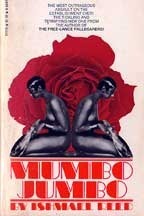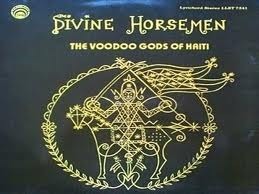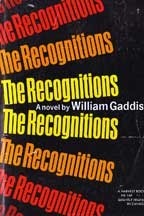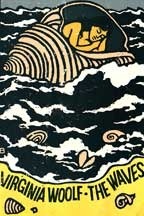Richard Melo's Blog
October 23, 2013
Book trailer that never was
While my recent novel was awaiting publication, I toyed with the idea of creating a book trailer. In the end, I did create a series of short films based on distinct themes in the novel, but these were more or less showcasing my research rather than promotional tools. The best viewers for the short films are people who have already read the book.
I had a touch of flu one day a couple of Decembers ago and put together a 60-second trailer incorporating Maya Deren’s Haitian voodoo footage and Les Paul’s song ‘Lover.’ (There’s a little Lee Hazlewood thrown in at the end and some surfing.) Sure, the video does capture a piece of the book’s mood, but it also misses so many of the book’s other atmospheres that I was never able to use this or anything like it to promote the book.
Now that the book has been out a while, it makes for a mysterious artifact of the novel’s early life.


October 9, 2013
Doing book tours is like spending too much time with an ex
I spent twelve happy years (1988-2000) writing my first novel. I gave the book the decade of my twenties. I made sacrifices, like not finishing my master’s degree and holding off on finding a decent job — all so I could work on the book.
Once I had a draft that felt finished, I didn’t know what to do next. I knew the book had flaws (all novels are flawed; the trick is to make the flaws awesome), and the temptation to start rewriting was always present.
The only way I found to stop was to break up with the book. Stop writing. Start thinking about working on new books. Hope that in time the allure will fade.
It worked. I never went back.
Then something happened. The novel was selected for publication. That meant spending months working on rewrites, and after the book came out, doing readings and tours. Like I said in the heading, these felt like spending too much time with an ex. Squirmy, uncomfortable, my heart not in it. To the rest of the world, novelist and novel look like a happy couple. The book was new to everyone else, but for me, I had moved on and was into my next novel.
The problem is after a few books, the break ups get more tiresome. Maybe there’s a better way to break with the writing process?


September 20, 2013
Super-old Melo bio
I found this bio I wrote several years ago and forgot to show anyone. (I am really not so self-centered as the bio suggests!)
Richard Melo is a Mod with a capital M that makes the word like God though Richard Melo himself is not a God but rather a Mad Cat who dresses like a shark. He’s in with the Peter Max set with a super-striped flare tie for every day of the week though today it’s a fuscia ascot and powder-blue shirt. His pants are pure white and hug at the ankle and stay up with the help of a belt around the waist held together by a brass buckle formed in the Shazam insignia. He wears leather boots with zippers along the side and drives too fast along Highway 1 in his Alfa Romeo. He throws his fist into the sky out the car’s open top. God, take that!
He also writes & his latest foray into Fictionland is the self-titled Jokerman 8, now available at fine booksellers everywhere from Soft Skull Press.


August 19, 2013
Dog suit
Michael O’Donoghue was a comedy-writing genius, whose works in National Lampoon and the mid-1970s Saturday Night Live have aged remarkably well. I’ve shown this clip to many people, and none seem to enjoy it as much as I do, but still I try. I don’t know what I appreciate more, the concept or the low-tech presentation.
It originally appeared as part of Mr. Mike’s Mondo Video from 1979.


July 27, 2013
Our Skylab Moments
Posted July 27, 2013, to commemorate the 40th anniversary of Skylab’s launch into space.
It was a run-for-your-life moment; Skylab was coming in hot. It was July, 1979, and kids like me were terrified. Skylab could crash anywhere, anytime. It was a Cuban Missile Crisis moment for my generation. It signaled the possibility of painful, instant death.
At the same time, it was exhilarating, and I really wanted to see Skylab crashing from the sky. Movies like Star Wars and Close Encounters (not to mention the Irwin Allen disaster movies) had whetted our appetite for special effects, and in the pre-CGI days, before movie special effect saturation, there was a thrill at the chance of seeing a fireball streaking across the sky. No one had seen anything like it before. Needless to say, when Skylab crashed in sparsely populated western Australia on July 12, 1979, it was a disappointment, the ultimate anti-climax, Y2K come 21 years early.
Skylab’s fall was also our Manson Family moment. Just as the Manson murders ended the 60s by sullying the hippie dream of peace and love, Skylab’s crash ended my generation’s astronaut dreams. By the late 1970s, time had sped up so much that projects like Skylab went from shining promise of space colonization to utter decay so quickly that it all happened within my childhood.
It was a dream I would never get back. It was a hollow dream, anyway.
Kids like me measured our dads against the All-American athlete/scientist astronauts. For kids without dads, I’m sure the hurt was even worse. For kids whose dads were indeed astronauts, I imagine even they wished their dads could be more like astronauts, so powerful was the image. For kids who weren’t white and male and able bodied, it could never be anything more than a dream. For white boys like me, you could excel at fourth-grade math and science and the Presidential Physical Fitness Award and hear teachers say you would grow up to be an astronaut and believe it to be true. Not all kids were hearing that.
With Skylab’s crash came an increasing awareness of the world. It was also around this time when I realized Tang was mostly just sugar. Puberty was setting in, and dreams of space travel were about to get replaced by new preoccupations, like thoughts of sex.
Space and sex don’t mix, or do they?
As an adult, I learned that there was a brief mutiny aboard Skylab by astronauts who badly needed a day off. I was writing my novel Happy Talk, which walks across the history of the post-WW II era and is filled with images of various creations creeping across the sky. By the early 1970s, Skylab was the ultimate expression of that. I began to wonder what my now fictionalized astronauts aboard Skylab would be thinking about on their day off. The best answer I could come up with was sex. Sex with their wives back on earth? Maybe. Sex with other astronauts’ wives? Maybe that, too. What sex would be like in space? I would wonder that. Sex with each other? Not out of the question. Would the Russians beat us in the “sex” race? They could.
I can’t say more without giving too much of the book away, but I can say Skylab provided the best possible location for me to end my novel and left me with this question: Why aren’t there more literary novels that end in space?
I freaking love Skylab. The wonderment that led to disillusion has led me to another place filled with nostalgia, which feels again like childlike wonderment. It’s breathtaking to see the image of that battered old bird with its broken solar panel hovering in orbit over earth. The home movies made by astronauts of their spacewalks and downtime clowning around conjure a nostalgia for my childhood when there were few things that mattered more than the space program.
The hope is that when future generations dream of interplanetary travel, it comes with the reality that there is plenty of space for everybody.
# # #
When researching my novel, Happy Talk, just published by Red Lemonade, I made a short film from vintage scenes from Skylab set to Tim Buckley’s ‘Song of the Siren,’ which can be seen on Vimeo.


July 10, 2013
Mexican Radio on Portland Radio
I was a freshman in suburban Portland, Oregon in 1982-83 when a small miracle occurred. The teeny-bopper radio stations, that seemed to be blaring wherever I went, started playing ‘Mexican Radio’ by Wall of Voodoo. Despite my youth, I understood what these radio stations were all about. They played just the most popular new songs in heavy rotation, and when one song started to wane, another came along and took its place — this hasn’t changed. It was all about profit and not about creating a sense of history as the stations would never play anything more than six months old.
‘Mexican Radio’ was a godsend. There had been a few other songs on radio that I had liked (the Go-Gos, Devo, Toni Basil) but ‘Mexican Radio’ was different. It was funny, and it was dark, and it was weird. I believed it was a watershed song, that I would never have to hear Laura Branigan or Toto or Hall & Oates music ever again because as soon as kids got a sense of how great Wall of Voodoo is, it’s all they would ever want to listen to. Could the Violent Femmes be next?
Kids on the high school debate team who a few weeks earlier would randomly wave a finger in the air and proclaim ‘Science!’ (inspired by the Thomas Dolby song) were now imitating Stan Ridgway’s vocal style and singing the refrain from ‘Mexican Radio’ out the sides of their mouth.
Sure enough, within days (not even weeks), ‘Mexican Radio’ was off the Portland airwaves, giving way to Nightranger and ZZ Top and Pat Benatar and sending me deep into my record collection, because all too often it seemed like in my town the only place to hear Siouxsie and the Banshees, or Elvis Costello, or Squeeze, or the Pandoras was on my turntable (or KBOO late at night, but that’s another story).
It wasn’t nearly as momentous, but hearing ‘Mexican Radio’ on Z100 was a little like when Obama was elected. It meant for once I would be able to stand listening to the radio. Song’s still around, and radio is same as ever.


July 8, 2013
New Happy Talk review
When your book comes out, you hope for reviews to appear. You never know exactly where reviews will come from or when, and sometimes, you even wait for reviews that never post. When a review does come online, you then hope that it’s positive, or at the very least, that the reviewer read the book well and gets it.
I’ve been incredibly fortunate that the five reviews Happy Talk has received so far have been positive, spectacular even. Here are bites from a new one from Shelf Awareness. All I can think is I’m not worthy:
If the late, great William Gaddis decided to haunt a guy who was possessed by Joseph Heller, that guy would be Richard Melo. How else can one explain Happy Talk? There has to be some dark, supernatural force behind this dialogue-based satire saturated in humor and wit.
Unabashedly hilarious and thoughtful in the way post-modernism used to be, Melo writes imaginative action sequences, delivers wonderwork prose and captures the voices of his characters like a fine tuned medium. Happy Talk is a rare feat–experimental and a joy to read.


June 26, 2013
Powells dream
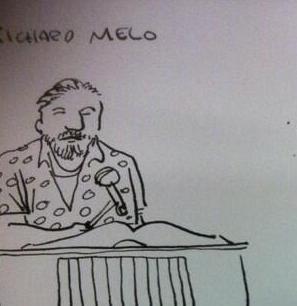
Sketch of Powells reading by Shannon Wheeler, June 25, 2013
Last night I had the extraordinary privilege to read from Happy Talk at Powells Books in Portland, Oregon. It’s just about the best thing that could happen to a writer from Portland. It was a fine experience, the audience seemed to groove on the book, I was able to try out a bunch of funny voices when acting out the dialogue, and the questions were insightful. One person asked where I got my Hawaiian shirt, to which I answered, ‘A thrift shop on Sandy Boulevard,’ which actually is a sound metaphor for all my writing. The more exotic it appears, the more likely I got it from a thrift shop on Sandy Boulevard.
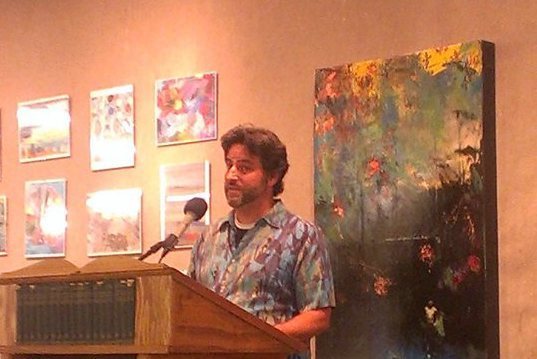
Wearing a Hawaiian shirt that came from a thrift shop on Sandy Boulevard
Before the reading, I was remembering the first time I went to Powells. It was the middle 1980s, and I was a kid from the suburbs who liked to ride the bus downtown on weekends to check out the used record shops. This was before Powells was as iconic as it is now. It was a bit more bohemian and low key at that time.
During that era, the rock ‘n’ roll books were by the front entrance, and rock ‘n’ roll was what I sought wherever I went. I was floored by how many rock books were on the shelves. I actually thought for a minute that the store sold nothing but rock books. I was a dumb and wishful kid, but I also had no idea that Powells was three floors and occupied a full city block (I am not sure all three floors were operational at the time.) All I knew was there were more rock books than I had ever seen.
Maybe it’s that first experience at Powells that led me to a recurring dream that comes along every few months. I’m in a dense urban area with awful traffic that goes out a peninsula. Where the peninsula ends, there’s a Powells Books with a view of the water. The reason this particular Powells is noteworthy is that it stocks books that don’t exist, masterpieces from my favorite authors that never were published. No matter the topic, this Powells has just the right book to satisfy even my most obscure curiosities. The theatre section is excellent, and in dreams, that’s where I go first.
The best part of the dream is that, with the exception of the peninsula and view of the water, Portland’s Powells Book often feels just like that!
Read my essay on the Kinks’ Waterloo Sunset on the Powells blog.
Buy my book from Powells. If you use this link, I actually get a cut of the action.


June 18, 2013
Recap
Happy Talk appears magically tomorrow, June 19, in bookstores and on bookshelves near you. It’s been a madcap few months, and here is a rundown of places where the novel has been reviewed or I have written essays over the past few weeks. My sincere thanks to the people who have helped support this book!
Rundown (in the always charming third person):
Melo writes about a Book Notes playlist (via largehearted boy) to accompany Happy Talk.
An essay on the Powells blog about Melo’s relationship with the Kinks’ ‘Waterloo Sunset.’
Happy Talk excerpt on The Collagist, June 2013.
Portland Monthly reviews Happy Talk, June 2013.
A Q & A in advance of the release of Happy Talk on Portland Monthly’s Culturephile blog, May 2013.
Publishers Weekly reviews Happy Talk, April 2013.
An essay on Joyland: The Real Portlandia, April 2013.
Matthue Roth talks Jokerman 8 and Happy Talk on Electric Literature, January 2013


June 13, 2013
Influencing Happy Talk
When I was doing readings from my first novel, Jokerman 8, there was one audience question that always came up in one form or another:
‘How much of the book is true?’
‘Did you spike trees? Sink whaling boats?’
‘Which character is based on you?’
I began to dread this reality-based line of questioning, not from any reclusive desire, but because my answer was so unsatisfying: ‘I made the whole thing up.’ No one wants to hear that.
Of course, there was quite a bit of my own experience in the book but it was covered with so many layers of fiction that it all seemed more imaginative than true.
To remedy my response to this question, I vowed that my next novel (which became Happy Talk) would be so out there that no one would think to ask which parts are me. I set the book in a place I’ve never traveled (Haiti) and in an era before I was born (the 1950s). Of course, once again, the book is based on my own emotional experiences but it’s even more deeply veiled.
A byproduct of writing a book like this is that you lean more heavily on your source material, which turned out to be one of the more enjoyable aspects of writing the novel. Happy Talk is a book that talks to other books. It’s one big, happy salute to its literary influences.
Here’s a quick look at a few of Happy Talk’s childhood heroes:
Mumbo Jumbo, by Ishmael Reed. When I read this novel, I felt there was second novel inside of it, a novel yet unwritten. The idea of Haiti as a spiritual pipeline from Africa and as well as white conspiracies to suppress all things African in origin gave Happy Talk its political and satirical impetus.
Divine Horsemen, by Maya Deren. I’m fascinated by the comic and dramatic possibilities surrounding voodoo possession — the idea of a spirit (or character) speaking through another person’s body. Maya Deren’s book, which started as a study of Haitian dance and ended as an ethnographic survey of voodoo, provides excellent source material, creating a deeply respectful portrait of the Haitian people of the countryside and their spirituality.
The Recognitions, by William Gaddis. This was a novel I had been searching for all my life before hearing about it for the first time in 2001. Gaddis can carry a story through dialogue like no other writer I’ve ever encountered (except maybe Dostoevsky). A writing trick I learned from The Recognitions: You don’t always need to identify who’s speaking if 1) the dialogue makes it obvious who the speaker is, or 2) it makes no difference to the story who the speaker is.
The Waves, by Virginia Woolf. One strength of the novel form is how it so easily allows readers to slip inside a character’s head. I’ve always loved this book and found the lyrical interior monologues incredibly moving. With Happy Talk, I decided to use dialogue to carry the story and Virginia Woolf-style monologue passages to maintain an emotional connection to the characters.
While those four books had the greatest effect on the novel, there are others I should mention as they were often in the back of head while I was writing: Catch-22, by Joseph Heller; There is a Tree More Ancient Than Eden, by Leon Forrest; On Thermonuclear War, by Herman Kahn, The Comedians, by Graham Greene; and O Pure and Radiant Heart, by Lydia Millet.



